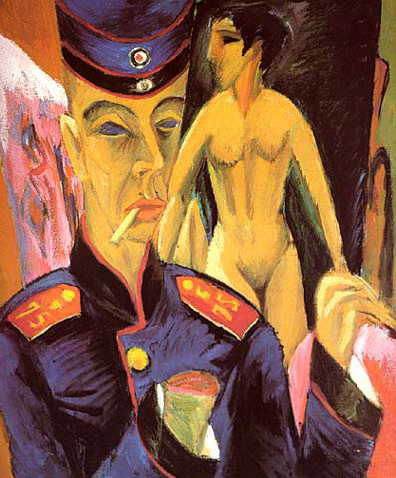|
An
Alle Kunstler! (To All Artists!)
The
German Expressionists - Essay by artist, Mark Vallen
|
|
|
I've
always been fascinated by the artists of the German Expressionist
movement and how they used their art to change society despite
overwhelming odds. The power of these artworks continues to resonate...
especially in light of today's catastrophic world events.
Ernst
Ludwig Kirchner painted the work at left titled, Self-Portrait
as a Soldier. The artist had himself been in the trenches
of WW1 and suffered a mental breakdown. Paintings like this got
the artist in trouble with the Nazis, who banned his work for
being "degenerate."
|
|
The
German Expressionist Movement was born in the trenches of World
War 1 in 1914. Many of the German soldiers who suffered through
that war were artists, and their experiences lead them to despise
the powerful elites who had sent them onto the battlefield. When
the war was lost in 1918 and Emperor Wilhelm abdicated, the people
rose to support the November Revolution - the socialist call for
the creation of a new Democratic Germany. Many artists answered
that call and worked to support and promote the new provisional
government.
|
The
Expressionists formed activist groups like the Arbeitsrat fur
Kunst (Worker's Council for Art), and the Novembergruppe (November
Group, named after the revolution itself), with the intent of
welding art to the worker's movement. In 1918 the November Group,
in their first manifesto, called upon all Cubists, Futurists,
and Expressionists to join in the regeneration of Germany. They
encouraged writers, composers, architects, and painters to participate
in the building of a new society.
|
|
Right-wing political opposition to the November
revolution began almost immediately, and within that opposition
lay the core of what was to later became the Nazi regime. The old
militarists and their wealthy backers were not about to relinquish
their power, and so they organized to defeat the November
revolution. In 1919 socialist leaders, Karl Liebknecht and Rosa
Luxembourg were arrested and murdered by rightists. A year later
the long planned coup of the radical right took place, with the
rightists seizing government buildings in Berlin. The coup failed
when 12 million German workers declared a general strike and drove
the right from power. That same year the right-wing
National
Socialist German Workers Party came into existence, and one of the
Nazi party members, a fanatical anti-Semite and racist anti-communist
by the name of Adolf Hitler became the party's best organizer and
orator.
|
| During
the rise of fascism, German Expressionists battled the right and tirelessly
attacked the forces of conservatism, militarism, and high finance.
Expressionists derided the status quo and made it a constant target
for their artworks. However, not all Expressionist artists were overtly
political - some turned towards religious themes in turning away from
the brutal realities of the time. Others took up portraiture or landscape
painting - but all came to despise the rightist thugs who strangled
art and democracy in Germany. It should come as no surprise that with
the eventual coming to power of the Nazis, many artists lost their
teaching positions and were forbidden to create or exhibit. Others
went into exile or were imprisoned... some were simply killed. |
| In
1937 the Nazi regime mounted an exhibition meant to ridicule modern
art. Titled Entartete Kunst (Degenerate Art), the exhibit featured
the works of Expressionists and other artists the regime deemed to
be "anti-German." The works put on display were denounced
by the Nazis as the dabblings of the insane, and the paintings were
labeled the works of "Jews" and "Communists."
Mockingly hung in poor light and at odd angles, the artworks were
draped with Nazi banners and labels that mocked the works as having
been created by the mentally and morally deficient. The exhibition
heralded the end of art in Germany... at least until the Nazi Regime
was finally done away with. |

|

|
|
|
|
| The
German artists who lived during the years covered in this presentation
labored under the most difficult of circumstances, war, extreme poverty,
repression, and finally, the terror of the Nazi regime. Yet somehow
they managed to leave behind a visual testament to their humanity
and ability to resist. It is beyond the scope of this web site to
present a complete overview of the Expressionists, rather, I hope
these pages will serve as an introduction to some of Germany's greatest
artists. |
|
www.art-for-a-change.com
is owned and operated by Mark Vallen © All text by Mark Vallen
|
|
















